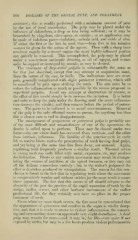Page 896 - My FlipBook
P. 896
906 DISEASES OF THE DENTAL PULP, AND TREATMENT.
necessary; this is readily performed with a minimum amount of pain
by the use of local anaesthetics. The pulp may be placed under the
influence of chloroform, a di'op or two being sufficient ; or it may be
benumbed by rhigolene, ether-spray, or cocaine ; or an application may
be made of iodoform paste—iodoform, carbolic acid, and oxide of zinc.
If either the first or the last be used, time—from five to ten minutes
—must be given for the action of the agents. Then Avith a sharp burr
revolved rapidly by a dental engine the most highly-inflamed portion
can quickly be removed. This accomplished, the pulp may be placed
under a non-irritant antiseptic dressing, as oil of cajeput, and event-
ually be capped or destroyed by arsenic, as may be desired.
The treatment of deep-Heated pulpitis is substantially the same as
for that just described, except that any attemjjt at amputation must,
from the nature of the case, be futile. The indications here are acute
pain, generally complicated with slight i^ersistent irritation, which will
be manifested by pain upon striking the teeth. The aim must be to
reduce the inflammation as much as possible by the means proposed in
superficial pulpitis. Avoid any attempt at destruction by arsenic, as
the effect of this would simply be to increase the irritation. It is better
and safer to keep the pulp under the dressing until the acute inflamma-
tion destroys the vitality, and then remove before the period of putres-
ence. The point to be enforced is to avoid over-treatment. Removal
of the pulp is the only effectual course to pursue, for anything less than
this is almost sure to end in disappointment.
The management of gangrenous or putrescent pulps is probably one
of the most difficult and unsatisfactory of any of the operations the
dentist is called upon to perform. These may be classed under two
forms—the one where death has occurred from extrinsic, and the other
from intrinsic, influences. The liability of the anterior teeth in early
life to receive blows makes the presentation of teeth having dead pulps,
and yet being at the same time free from decay, not unusual. Again,
regulating teeth frequently produces a similar result. Thermal action
in young teeth too early filled with metal, exposures, etc. may produce
devitalization. Blows or any sudden movement may result in strangu-
lating the sources of nutrition at the apical foramen, or they may cut
off" the delicate connections entirely ; but in the writer's judgment the
effect is doubtless produced by strangulation. The reason for this con-
clusion is found in the fact that in regulating teeth where the movement
is comparatively regular and Mithout sudden jar the same result is some-
times apparent. The fact that this occurs at all should relegate to the
obscurity of tlie past the practice of the rapid separation of teeth by the
M-edge, mallet, screws, and other barbaric instruments of the earlier
professional life, for they certainly no^v have no place in the proper
treatment of teeth.
From whatever cause death occurs, the fact must be remembered that
the appearance of quiescence and comfort in the organ is wholly decep-
tive, and that it is ready to arouse to violent inflammation the connect-
ing and surr(tun
exposed by caries, but may in a fe\y hours produce violent pericementitis


